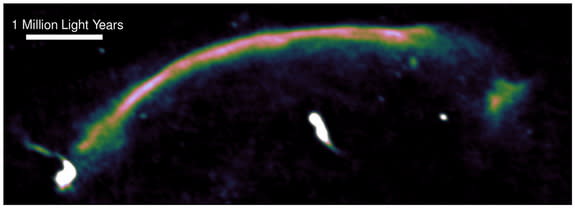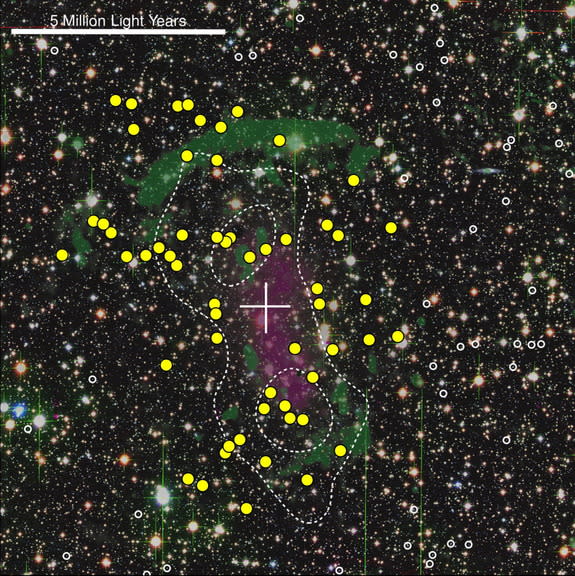'Cosmic Tsunami' Shocks Comatose 'Sausage' Galaxy Cluster Into Star Formation
A so-called "cosmic tsunami" is rousing a galaxy cluster affectionately nicknamed "Sausage," suggesting that stagnant galaxies can be rejuvenated when galactic clusters collide, scientists say.
Astronomers made the discovery while studying CIZA J2242.8+5301, an ancient galaxy cluster 2.3 billion light-years from Earth. The cluster (yes, they actually call it Sausage), which is full of old red stars, is waking up as a shock wave triggers new star formation. The shock wave from the cluster's collision, which scientists compared to a tsunami, began 1 billion years ago and is moving at a mind-boggling speed: 5.6 million mph (9 million km/h).
"We assumed that the galaxies would be on the sidelines for this act, but it turns out they have a leading role," study co-leader Andra Stroe, an astronomer at Leiden Observatory, said in a statement. "The comatose galaxies in the Sausage cluster are coming back to life, with stars forming at a tremendous rate. When we first saw this in the data, we simply couldn't believe what it was telling us." [Epic Photos: When Galaxies Collide]
This is the first time such star formation has been observed, but in theory nearly every galaxy cluster should have passed through this period of furious star formation. Alas, such a resurrection is not meant to last, the researchers said.
"But star formation at this rate leads to a lot of massive, short-lived stars coming into being, which explode as supernovae a few million years later," the study's other co-leader, David Sobral of Leiden and the University of Lisbon, said in a statement. "The explosions drive huge amounts of gas out of the galaxies and with most of the rest consumed in star formation, the galaxies soon run out of fuel. If you wait long enough, the cluster mergers make the galaxies even more red and dead — they slip back into a coma and have little prospect of a second resurrection."
Stroe, Sobal and an international team of astronomers used several telescopes and observatories in La Palma, Spain, and in Hawaii to study the Sausage galaxy cluster, which is located in the constellation Lacerta (the Lizard) in the Northern Hemisphere sky. Their research was detailed in the April 24 edition of the Monthly Notices of the Royal Astronomical Society.
The team plans to sample a larger number of galaxies soon to try to catch more of these comatose mergers in the act.
Follow Elizabeth Howell @howellspace, or Space.com @Spacedotcom. We're also on Facebook and Google+. Originally published on Space.com.
Copyright 2015 SPACE.com, a Purch company. All rights reserved. This material may not be published, broadcast, rewritten or redistributed.



